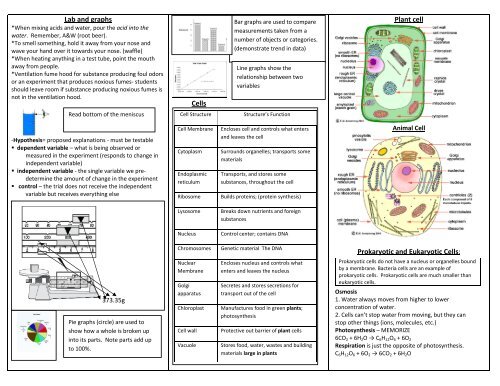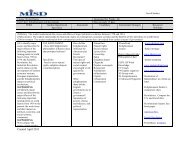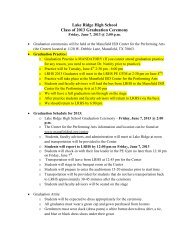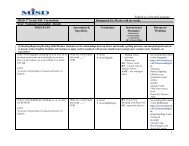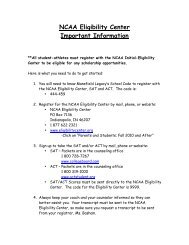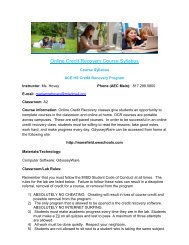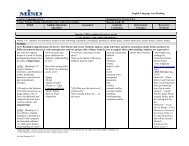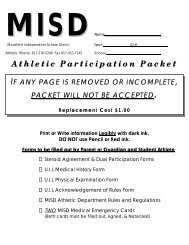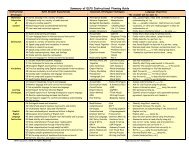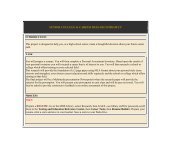Lab and graphs Cells Plant cell Prokaryotic and Eukaryotic Cells:
Lab and graphs Cells Plant cell Prokaryotic and Eukaryotic Cells:
Lab and graphs Cells Plant cell Prokaryotic and Eukaryotic Cells:
You also want an ePaper? Increase the reach of your titles
YUMPU automatically turns print PDFs into web optimized ePapers that Google loves.
<strong>Lab</strong> <strong>and</strong> <strong>graphs</strong><br />
*When mixing acids <strong>and</strong> water, pour the acid into the<br />
water. Remember, A&W (root beer).<br />
*To smell something, hold it away from your nose <strong>and</strong><br />
wave your h<strong>and</strong> over it towards your nose. (waffle)<br />
*When heating anything in a test tube, point the mouth<br />
away from people.<br />
*Ventilation fume hood for substance producing foul odors<br />
or an experiment that produces noxious fumes‐ students<br />
should leave room if substance producing noxious fumes is<br />
not in the ventilation hood.<br />
<strong>Cells</strong><br />
Bar <strong>graphs</strong> are used to compare<br />
measurements taken from a<br />
number of objects or categories.<br />
(demonstrate trend in data)<br />
Line <strong>graphs</strong> show the<br />
relationship between two<br />
variables<br />
<strong>Plant</strong> <strong>cell</strong><br />
Read bottom of the meniscus<br />
Cell Structure<br />
Structure’s Function<br />
‐Hypothesis= proposed explanations ‐ must be testable<br />
• dependent variable – what is being observed or<br />
measured in the experiment (responds to change in<br />
independent variable)<br />
• independent variable ‐ the single variable we predetermine<br />
the amount of change in the experiment<br />
• control – the trial does not receive the independent<br />
variable but receives everything else<br />
Cell Membrane<br />
Cytoplasm<br />
Endoplasmic<br />
reticulum<br />
Ribosome<br />
Encloses <strong>cell</strong> <strong>and</strong> controls what enters<br />
<strong>and</strong> leaves the <strong>cell</strong><br />
Surrounds organelles; transports some<br />
materials<br />
Transports, <strong>and</strong> stores some<br />
substances, throughout the <strong>cell</strong><br />
Builds proteins; (protein synthesis)<br />
Animal Cell<br />
Lysosome<br />
Breaks down nutrients <strong>and</strong> foreign<br />
substances<br />
Nucleus<br />
Control center; contains DNA<br />
Chromosomes<br />
Genetic material The DNA<br />
<strong>Prokaryotic</strong> <strong>and</strong> <strong>Eukaryotic</strong> <strong>Cells</strong>:<br />
373.35g<br />
Pie <strong>graphs</strong> (circle) are used to<br />
show how a whole is broken up<br />
into its parts. Note parts add up<br />
to 100%.<br />
Nuclear<br />
Membrane<br />
Golgi<br />
apparatus<br />
Chloroplast<br />
Cell wall<br />
Vacuole<br />
Encloses nucleus <strong>and</strong> controls what<br />
enters <strong>and</strong> leaves the nucleus<br />
Secretes <strong>and</strong> stores secretions for<br />
transport out of the <strong>cell</strong><br />
Manufactures food in green plants;<br />
photosynthesis<br />
Protective out barrier of plant <strong>cell</strong>s<br />
Stores food, water, wastes <strong>and</strong> building<br />
materials large in plants<br />
<strong>Prokaryotic</strong> <strong>cell</strong>s do not have a nucleus or organelles bound<br />
by a membrane. Bacteria <strong>cell</strong>s are an example of<br />
prokaryotic <strong>cell</strong>s. <strong>Prokaryotic</strong> <strong>cell</strong>s are much smaller than<br />
eukaryotic <strong>cell</strong>s.<br />
Osmosis<br />
1. Water always moves from higher to lower<br />
concentration of water.<br />
2. <strong>Cells</strong> can’t stop water from moving, but they can<br />
stop other things (ions, molecules, etc.)<br />
Photosynthesis – MEMORIZE<br />
6CO 2 + 6H 2 O → C 6 H 12 O 6 + 6O 2<br />
Respiration is just the opposite of photosynthesis.<br />
C 6 H 12 O 6 + 6O 2 → 6CO 2 + 6H 2 O
DNA;<br />
T match with A<br />
C match with G<br />
Replication<br />
DNA<br />
Troy Aikman<br />
Go Cowboys<br />
The double‐str<strong>and</strong>ed DNA molecule has<br />
the unique ability that it can make exact<br />
copies of itself.<br />
RNA<br />
RNA contains the bases adenine (A), cytosine (C) <strong>and</strong><br />
guanine (G); however, RNA does not contain thymine,<br />
instead, RNA's 4th nucleotide is the base Uralic (U)<br />
U match with A C match with G<br />
• Transcription‐‐The synthesis of messenger RNA from a<br />
DNA template.<br />
• Translation‐‐The synthesis of a protein in the ribosome<br />
from a messenger RNA template.<br />
Mutation = A change in the DNA of an organism. Classified<br />
as insertion (addition of a base), deletion (subtraction of a<br />
base), or substitution (replacement of one base with<br />
another).<br />
Systems<br />
Circulatory<br />
Function: to transport blood to every part of the body.<br />
In the blood are all of the necessary gases, nutrients,<br />
<strong>and</strong> waste<br />
Digestive<br />
Function: to digest food <strong>and</strong> provide vital nutrients to<br />
the body. Eliminate wastes.<br />
Nervous<br />
Function: controls all bodily activities.<br />
Endocrine<br />
Function: secrete hormones<br />
Reproductive<br />
Function: to perpetuate the species through<br />
reproduction.<br />
Integumentary (skin)<br />
Function: regulating your body temperature, serves as a<br />
protective layer to the underlying tissues.<br />
Skeletal<br />
Function: provides a framework for the tissue of the<br />
body, protects the upper organs, muscles are anchored<br />
to the bones to allow for movement, produce blood<br />
<strong>cell</strong>s, <strong>and</strong> store vital minerals.<br />
Respiratory<br />
Function: provide the body with oxygen, <strong>and</strong> also to<br />
dispel carbon dioxide from the body.<br />
Muscular<br />
Function: Smooth muscle allows for the contraction of<br />
organs (moves food along the intestines) <strong>and</strong> blood<br />
vessels (pushes blood through). Cardiac muscle is<br />
responsible for the pumping of the heart. Skeletal<br />
muscle allows for all movement of the body.<br />
Excretory/Urinary<br />
Function: filter the blood <strong>and</strong> remove major waste<br />
products such as ammonia <strong>and</strong> urea.<br />
Immune/Lymphatic<br />
Function: protect the body from infections <strong>and</strong><br />
antigens.<br />
mRNA fragment that was originally CUU what amino acid is<br />
produced?
Taxonomy<br />
King‐‐Phillip‐‐Came‐‐Over‐‐For‐‐Good‐‐<br />
Soup<br />
Binomial nomenclature – “2 name system” uses the genus<br />
<strong>and</strong> the species to identify an organism. (homo sapiens)<br />
Humans<br />
Kingdom ‐ animals<br />
Phylum ‐ chordates<br />
Class ‐ mammals<br />
Order ‐ primates<br />
Family ‐ hominids<br />
Genus ‐ homo<br />
Species ‐ sapiens<br />
General<br />
↓<br />
Specific<br />
<strong>Plant</strong> Adaptation<br />
An adaptation is defined as anything that helps an<br />
organism survive <strong>and</strong> successfully reproduce in an<br />
ecosystem.<br />
1. Open/close stomata‐conserves better water.<br />
2. Less sun‐bigger leaves.<br />
3. waxy leaves less conserve water<br />
4. dry capsule, seeds with fine fluff, winged fruits or<br />
seeds are adapted for wind dispersal<br />
5. fleshy fruit animals eat <strong>and</strong> excrete seeds<br />
6. dried seeds with hooks or spines such as Coclé burrs<br />
are adapted for animal dispersal<br />
7. tap rots allow plant to access underground water<br />
Viruses:<br />
1. Not alive.<br />
2. Contain:<br />
• DNA or RNA to take control of the <strong>cell</strong>.<br />
• Protein shell to “trick” the <strong>cell</strong> into acceptance.<br />
3. Not killed by anti‐biotic.<br />
• Anti‐biotic doesn’t work on viruses.<br />
4. Vaccine‐ A protein shell or a similar virus given<br />
to a person where they will build up a resistance<br />
to a bad virus.<br />
5. Types Commonly seen on TAKS:<br />
• HIV‐ Viruses attack T‐<strong>cell</strong>s (white blood <strong>cell</strong>s).<br />
• Influenza‐ “flu”.<br />
• Smallpox‐ Like chickenpox on steroids.<br />
Food Chains Webs And Pyramids<br />
• The Sun, which provides the energy for everything on<br />
the planet.<br />
• Producers: these include all green plants. Use sun<br />
energy for photosynthesis to make food for all<br />
consumers.<br />
• Consumers: include herbivores (animals that eat<br />
plants), carnivores (animals that eat other animals),<br />
omnivores eat plants <strong>and</strong> animals.<br />
• Decomposers: These are mainly bacteria <strong>and</strong> fungi that<br />
convert dead matter into gases such as carbon <strong>and</strong><br />
nitrogen to be released back into the air, soil, or water<br />
• Autotrophs – produce their own food (example: plants).<br />
• Herbivore – plant eaters (example: deer).<br />
• Omnivore – eats both plants <strong>and</strong> meat (example: bear).<br />
• Carnivore – eats primary meat (example: coyote).<br />
• Decomposers – breaks down dead tissue (example:<br />
bacteria).<br />
• Producer‐ also known as autotrophs produces its own<br />
food.<br />
Symbiosis<br />
1. Predation is a relationship in which one organism<br />
preys on another as a source of food. An example of<br />
predation is an owl hunting a field mouse.<br />
2. Parasitism is a relationship in which one organism<br />
derives benefit at the expense of the other.<br />
Commensalism is a relationship in which one organism<br />
derives benefit with neither benefit nor harm to the<br />
other.<br />
3. Mutualism is a relationship in which both organisms<br />
benefit from each other.<br />
Beneficial Bacteria<br />
• Help make essential soil mineral elements, available to<br />
the plant Nitrogen Fixation<br />
• Decompose organic matter <strong>and</strong> improve physical<br />
properties of the soil<br />
• Vast numbers of bacteria live in our bodies. One<br />
example is found in the intestine. This bacteria <strong>and</strong><br />
humans have formed a symbiosis with each other. The<br />
bacteria help us with digestion <strong>and</strong> to produce vitamins.<br />
In exchange, they soak up a little extra food for<br />
themselves<br />
• Bacteria also make, or help to make, drugs, hormones,<br />
or antibodies.<br />
• Bacteria can even help to break down oil to make cleanup<br />
after an oil spill easier.<br />
Classification of Matter
Periodic Table<br />
Writing formulas<br />
Criss cross <strong>and</strong> reduce oxidation numbers, write metal<br />
first<br />
Atomic number = number protons/ all atoms of the same<br />
element have same number of protons<br />
What element is<br />
depicted by the<br />
picture of the<br />
atom? 4 protons<br />
= the element<br />
with an atomic<br />
number of 4= Be<br />
Metals lose electrons <strong>and</strong> become positive ions<br />
Nonmetals gain electrons <strong>and</strong> become negative ions<br />
Group 18 (noble gas) do not react (do nothing)<br />
Semimetals to left of left of zig zag line act like<br />
nonmetals <strong>and</strong> to the right act like metals<br />
Oxidation numbers metal + nonmetal ‐<br />
+ Protons‐Positive charge<br />
0 Neutrons –No charge<br />
‐ Electrons‐Negative charge<br />
Elements in<br />
same group<br />
have similar<br />
properties<br />
Physical Change<br />
• Changes of state or appearance.<br />
• forming a solution<br />
• Same stuff stays the same stuff.<br />
Chemical Change<br />
• Release of energy, forms bubbles without heating,<br />
two solutions make a solid, color change<br />
• rotting, digestion, with an acid, rusting, burning,<br />
• New substance formed<br />
Law of Conservation of Matter<br />
Equations must be balanced because: Law of Conservation<br />
of Matter: Same number atoms of each type before <strong>and</strong><br />
after a reaction, so there must be the same number of<br />
atoms on both sides of the equation. The mass of all the<br />
reactants (the substances going into a reaction) must<br />
equal the mass of the products (the substances produced<br />
by the reaction).
Balancing an Equation<br />
1. Draw boxes around all the chemical formulas. Do not change<br />
anything inside the box! Here's what the equation looks like:<br />
2. Make an element inventory. Let side of the equation is the<br />
before <strong>and</strong> right side is the after.<br />
3. Write numbers in front of each of the boxes until the<br />
inventory for each element is the same both before <strong>and</strong> after the<br />
reaction. Now, what happens when we put a number in front of a<br />
formula? Basically, anything in that box is multiplied by that<br />
number.<br />
Acids & Bases<br />
ACIDS<br />
Litmus blue to red, Taste sour, Corrosive to metals, Produce<br />
H + in water, Less acidic w/ base<br />
BASES<br />
Litmus red to blue, Fell slippery, Produce OH ‐ in water<br />
Less basic w/ acid<br />
FACTORS INCREASE THE RATE<br />
OF A SOLUTE DISSOLVING IN WATER:<br />
1. grinding, crushing<br />
2. stirring, swirling<br />
3. increase temperature<br />
FACTORS INCREASE SOLUBILITY OF A GAS:<br />
1. ↓ temperature ↑ gas solubility<br />
2. ↑ pressure ↑ gas solubility<br />
FACTOR INCREASE SOLUBILITY OF A SOLID:<br />
1. ↑ temperature often ↑ solubility<br />
Water<br />
Is polar because of its<br />
molecular shape (geometry)<br />
causing may substance to<br />
dissolve in water<br />
Well, looking at the new inventory, we can see that we now have<br />
two sodium atoms on both the left <strong>and</strong> the right sides, but the<br />
others still don't match up. You can see from the inventory that<br />
on the right side of the equation, there are two hydrogen atoms<br />
<strong>and</strong> on the left there are four. Put a "2" in front of the water on<br />
the right side of the equation to make the hydrogens balance out.<br />
A new inventory that looks something like this:<br />
Since both sides of the inventory match, the equation is now<br />
balanced! All other equations will balance in exactly the same<br />
way, though it might take a few more steps in some cases.<br />
Strong electrolytes<br />
completely breaks apart<br />
into ions<br />
solutions strongly<br />
conduct electricity<br />
Electrolytes<br />
Non-electrolytes<br />
does not break apart<br />
solutions don't<br />
conduct electricity<br />
Ice is less dense than liquid<br />
water because of the empty<br />
space in ice.<br />
ICE floats <strong>and</strong> is a good<br />
insulator<br />
Density, Viscosity, Buoyancy, Archimedes<br />
Principle<br />
Density<br />
Less dense float<br />
more dense sinks<br />
Density = <br />
<br />
Which is denser?<br />
Viscosity‐Resistance to “Flow” –more viscous the slower<br />
it pours<br />
Buoyancy‐ is a measure of the upward pressure a fluid<br />
exerts on an object.<br />
Archimedes principle ‐the force exerted on an object in a<br />
liquid is equal to the weight of the fluid displaced by the<br />
object
Bonding<br />
Newton’s Laws<br />
1st‐ Every object in a state of uniform motion tends to<br />
remain in that state of motion unless an external force is<br />
applied to it.<br />
Energy<br />
Kinetic Energy‐Motion<br />
Potential Energy‐Position (Not moving) ball on top o hill<br />
Electrical Energy‐ Electronics, Generators<br />
Chemical Energy‐ Batteries, Sugar <strong>cell</strong>s<br />
Solar Energy‐ Sunlight‐Photosynthesis‐solar <strong>cell</strong>s<br />
Mechanical Energy‐Machines moving<br />
Nuclear Energy‐ Atoms splitting, decay<br />
Thermal Energy‐ heat<br />
Types Waves<br />
Ionic Bonds occurs between metal <strong>and</strong> a nonmetal<br />
atoms or a metal atom <strong>and</strong> a negative polyatomic ion<br />
Covalent bonds occur between two non‐metal atoms<br />
Units To MEMORIZE<br />
Mass‐ grams (g), kilograms (kg)<br />
Distance‐ meters (m), centimeters (cm)<br />
Time‐seconds, minutes<br />
Force‐ Newtons (N)<br />
Work or Energy‐ Joules (J)<br />
Power‐ Watts (W)<br />
Momentum‐ kgm/s<br />
Speed or velocity‐ m/s<br />
Acceleration‐ m/s 2<br />
Heat<br />
Conduction:<br />
Transfer from one substance to another by direct contact<br />
of molecules.<br />
Example: When you touch a hot stove.<br />
Convection:<br />
Heat carried from one place to another in a liquid or gas as<br />
molecules move in currents caused by density differences.<br />
Example: Warm air rising.<br />
Radiation:<br />
Heat carried through empty space in the form of infrared<br />
rays.<br />
Example: When you face the sun <strong>and</strong> feel warmth on your<br />
face<br />
2nd‐ F = ma. Force=Mass times Acceleration<br />
3rd‐For every force there is an equal <strong>and</strong> opposite reactive<br />
force. Forces always come in pairs ‐ equal <strong>and</strong> opposite<br />
action‐reaction force pairs.<br />
Examples of transverse waves‐visible light, Infra Red light,<br />
Ultra Violet light, gamma rays, x‐rays, AM‐FM radio,<br />
microwave, etc.<br />
Examples of longitudinal waves‐A loudspeaker cone<br />
moves back‐<strong>and</strong>‐forth to create a sound, which is a<br />
compression wave. AC electricity Electrons move back‐<strong>and</strong>forth<br />
in a wire, sending a wave of electric power through<br />
the wire.
Properties of Waves<br />
Amplitude is the height of a wave from the resting position.<br />
As the energy of a wave increases, amplitude increases.<br />
The frequency represents the number of waves that pass<br />
by a point every second. As the energy of a wave increases;<br />
frequency increases.<br />
Wavelength is the distance between two corresponding<br />
points on a wave. As the energy of a wave increases,<br />
wavelength decreases.<br />
Reflections: means to bounce off a surface ‐mirror<br />
Refractions: means to bend through an object<br />
Frequency<br />
The frequency is the number of cycles (wave’s crests) per<br />
unit time. Frequency is also called the pitch of a sound. It<br />
corresponds to the note in musical sounds. The pitch of a<br />
sound is determined by its wavelength or its frequency.<br />
Resonance<br />
When one object vibrating at the same natural frequency<br />
of a second object forces that second object into<br />
vibrational motion. Resonance is a common cause of sound<br />
production in musical instruments.<br />
Polarized light <strong>and</strong> Filters<br />
‐ light travels in waves that can go in different directions<br />
(up & down, side to side)<br />
‐ if a filter with slits in only one direction is used , those<br />
waves traveling the other direction will be blocked out<br />
‐ polarized light is the light that makes it through those<br />
slits<br />
‐ glare, the light that makes you squint, is mainly<br />
horizontal (sideways) waves <strong>and</strong> so sunglasses are designed<br />
to block out those light waves reducing glare<br />
‐ filters block out certain wavelengths <strong>and</strong> allow only<br />
certain waves through<br />
Interference<br />
Constructive interference: If the crests of the original waves<br />
line up with one another, the resulting wave will have<br />
larger amplitude (height) than either of the original waves.<br />
Destructive Interference: Destructive interference can<br />
occur when the crests of one wave line up with the troughs<br />
of another wave. In this case, the amplitude of the<br />
combined wave is equal to the larger wave’s amplitude<br />
minus the smaller wave’s amplitude. If the waves have the<br />
same amplitude, then the waves cancel each other out.<br />
Diffraction: the wave wraps around an edge.<br />
‐
Formula Chart<br />
• On the science chart, the meanings of the letters<br />
in the formulas are given to you.<br />
• You must know the measurement units to know<br />
what numbers fit to which letter.<br />
The box at the bottom provides some help . . . Let’s<br />
look<br />
What is the net force exerted on a 90.0 kg race‐car driver<br />
while the race car is accelerating from 0 to 44.7 m/s<br />
in 4.50 s?<br />
The following information is used from the<br />
formula chart<br />
Science questions sometimes give more information<br />
than is needed.<br />
A person pushes a large box across a level floor by applying<br />
a horizontal force of 200 N. If the person pushes the<br />
box a distance of 5 meters in 10 seconds, how much<br />
work does the person do on the box?<br />
Time is not needed to<br />
find work<br />
When solving problems<br />
• Match units to formulas on the formula page.<br />
• Time should be in seconds for all formulas.<br />
• When calculating Force, Momentum, Work <strong>and</strong><br />
Power mass must be in Kilograms.<br />
• Work <strong>and</strong> energy must be in Joules or Newtonmeters<br />
(Nm).<br />
We see kg, but not m/s 2 , so we have to calculate<br />
acceleration first. .<br />
Acceleration = Vf – Vi<br />
time<br />
A = 44.7 – 0 = 9.9 m/s 2<br />
4.5<br />
F= ma = 90.0kg x 9.9 m/s 2 = 893.9 N<br />
Work = force x distance<br />
No mention of time!<br />
W= Fd<br />
200N x 5 m = 1000 joules


